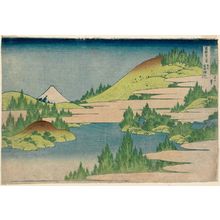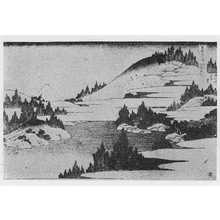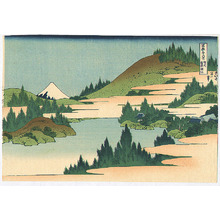Estampe japonaise "The Lake at Hakone in Sagami Province" par Katsushika Hokusai
Artiste :Katsushika Hokusai
Titre :The Lake at Hakone in Sagami Province
Date :c. 1830 - 1834
Détails :Plus d'informations...
Source :Honolulu Museum of Art
Parcourir toutes les 5 476 estampes...
Description :
Lying to the east of Fuji, the mountainous region near Hakone, with peaks of nearly 4000 feet, was the most difficult area for travelers on the Tökaidö Road. In the 20 miles between the Odawara and Mishima stations, the road rose and fell, passing Lake Ashinoko at a high altitude and also Hakone station. In 1618, a checkpoint (sekisho) or barricade was established at Hakone to inspect travelers, especially women and young maidens, who underwent stringent identity checks. The shogunate was especially concerned about preventing the wives and daughters of local daimyö from escaping Edo, where they were obliged to reside as virtual hostages under the policy of alternate attendance (sankin-kötai). This required the daimyö to spend a year in Edo at the court, then a year on his own lands – but his family had to remain in Edo as surety for his loyalty. To pass the checkpoint, both men and women had to show their travel permits, a kind of passport issued by their village or town officials. In this print, the deep blue waters of the high Lake Ashinoko lap the rounded hills of yellow-green. To the left of the brown mountain, Fuji, covered with snow, looms against the blue sky. Its perfect conical shape contrasts with the rolling shapes of the surrounding region. The Hakone shrine is at the right. The composition is one of only a few works with no human or animal figures. The overuse of decorative clouds somewhat impairs the dynamic views of the site. The key-block was printed in blue. (The Asian Art Museum of San Francisco, HOKUSAI AND HIROSHIGE – Great Japanese Prints from the James A. Michener Collection, Honolulu Academy of Arts: The Asian Art Museum of San Francisco, 1998 Page 88. Cat. 39) ***************** Hakone was one of the most important stations on the Tökaidö (“East Sea Road”). Its high mountains made this a particularly difficult section to traverse, and all traffic was carefully monitored at a government checkpoint. The region is famous for its view of Mount Fuji beyond Lake Ashi, shown here partially shrouded in mist. Although the pass usually was bustling with activity, Hokusai presents a mystical landscape devoid of human presence, except for the sacred Hakone shrine nestled in the trees. The rounded hills, mineral colors, and suyarigasumi stylized clouds are reminiscent of traditional yamato-e (literally “Japanese-style painting”), which dates back to the Heian period (794-1192). The soft mood of the yamato-e landscape contrasts with the sharp cone of Mount Fuji, and Hokusai may intentionally have utilized this style to add drama to his depiction of the mountain. “Hokusai’s Summit: Thirty-six Views of Mount Fuji” (09/24/2009-01/06/2010) ******************************
Estampes Similaires


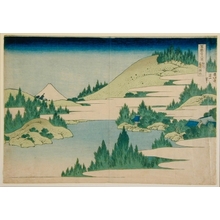







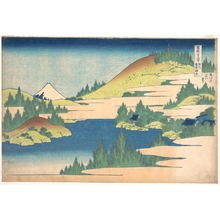




![[Sōshū hakone kosui] Estampe japonaise "[Sōshū hakone kosui]" par Katsushika Hokusai, 葛飾北斎 (Katsushika Hokusai)](https://data.ukiyo-e.org/loc/thumbs/02471v.jpg)
